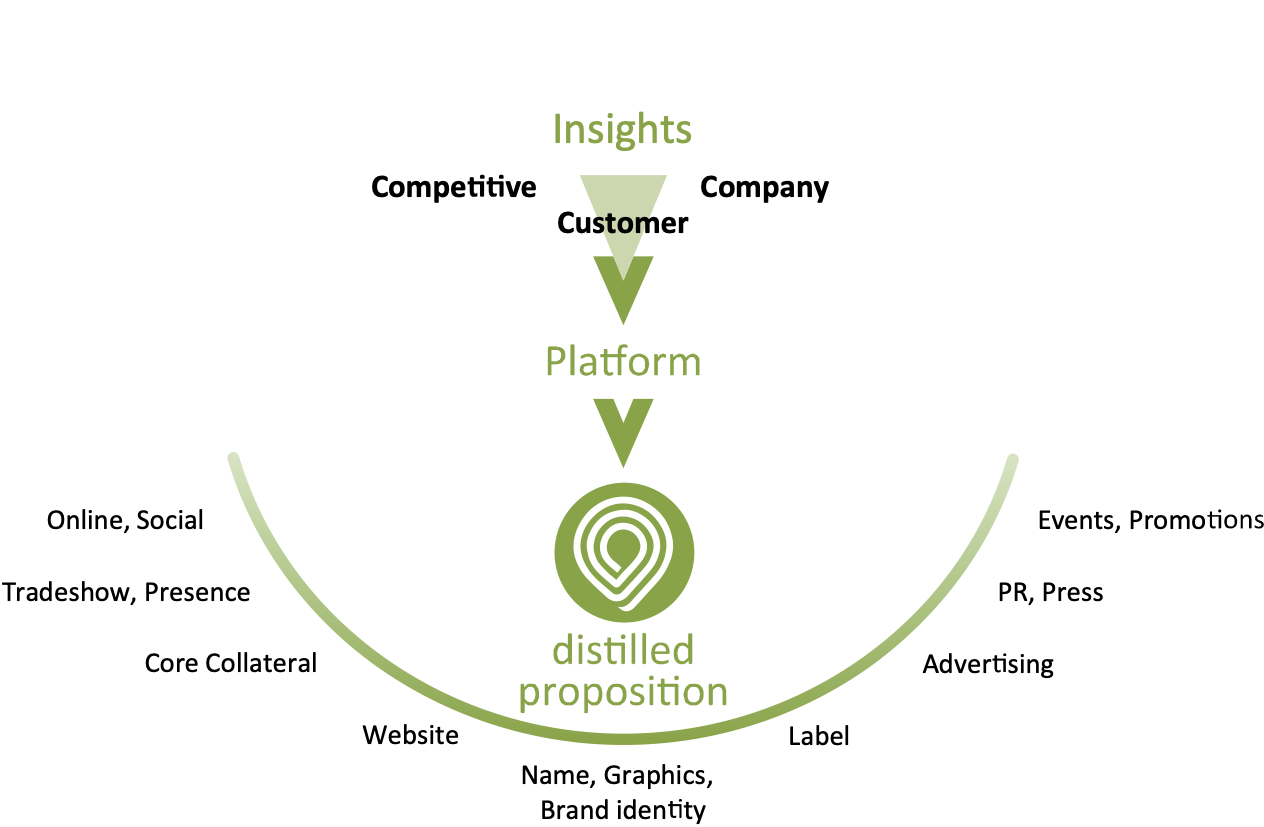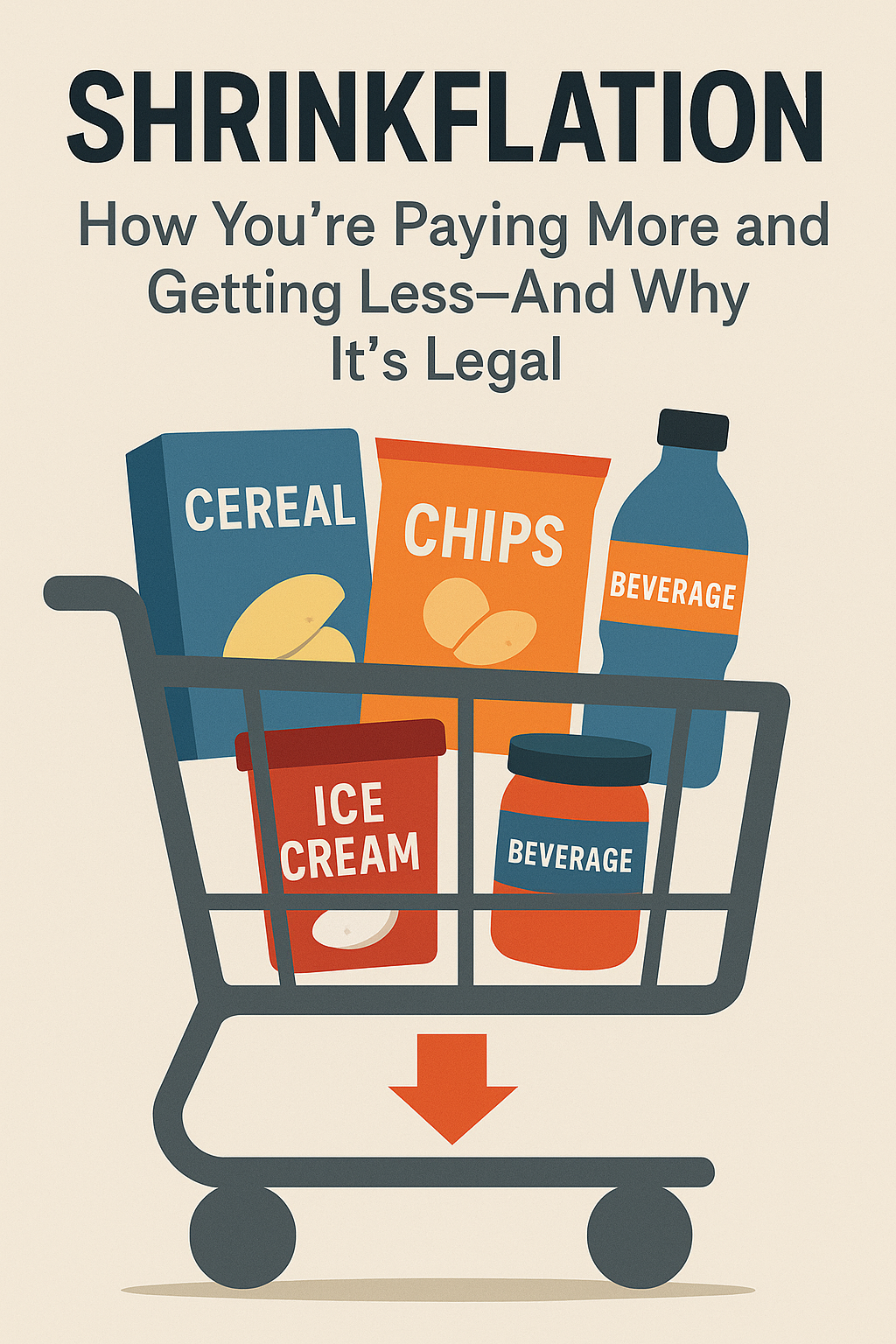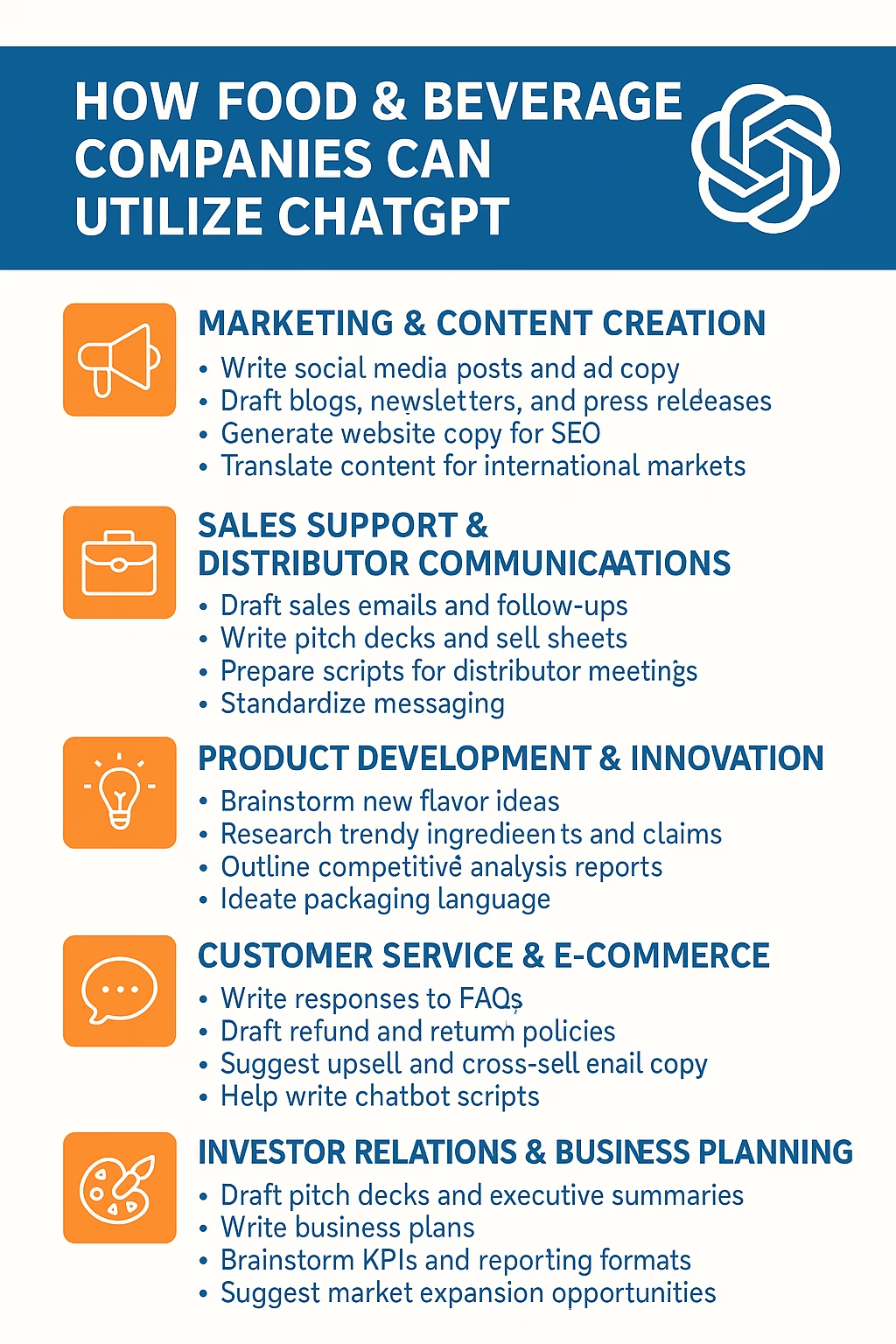This roadmap serves as a strategic compass for anyone building a brand—from early-stage entrepreneurs to CMOs at global companies. Follow…
Blending Strategy with Inspiration: A Comprehensive Social Media Guide for Food and Beverage Brands with Real-World Examples
In the ever-evolving landscape of digital marketing, the power of social media stands as a towering beacon of opportunity for food and beverage brands. This guide not only walks you through a strategic approach to mastering social media but also enriches each step with real-world examples from industry giants.
The Awakening to Social Media’s Power We begin our journey acknowledging the critical role of social media in modern marketing. Brands like Coca-Cola have demonstrated that social media is more than a communication platform; it’s a powerful tool for engaging customers and building brand loyalty. Their #ShareACoke campaign is a testament to the impact of a well-crafted strategy, creating a global sensation and illustrating the power of personalized content.
Understanding the Audience Knowing your audience is the cornerstone of an effective social media strategy. Red Bull sets a high standard in this aspect, targeting a young, adventurous demographic. Their content across Instagram and YouTube resonates with this audience’s lifestyle, resulting in high engagement and loyalty. This teaches us the importance of tailoring content to audience preferences.
Understanding your social media audience is crucial for making appropriate and effective marketing decisions. Brands can determine who their audience is on social media through a combination of research, analysis, and engagement strategies. Here’s how a brand can find out about its social media audience:
- Review Social Media Analytics:
- Most social media platforms offer built-in analytics tools (e.g., Facebook Insights, Instagram Insights, Twitter Analytics, TikTok Analytics).
- These tools provide valuable data on the demographics of your followers (age, gender, location), their online behaviors (when they are active, what content they engage with), and how they interact with your posts.
- Engage Directly with Your Audience:
- Interacting with your audience through comments, polls, or direct messages can provide insights into their preferences and opinions.
- Conducting surveys or asking for feedback on your social media channels can also be an effective way to understand your audience better.
- Monitor Engagement and Content Performance:
- Analyze which types of posts generate the most engagement (likes, shares, comments) and adjust your content strategy accordingly.
- Pay attention to the tone and nature of the comments to gauge audience sentiment and interests.
Measuring social media engagement and determining the success or failure of a post is crucial for any brand looking to optimize its social media strategy. There are several metrics and standards considered best practices in the industry:
- Engagement Rate:
- This is a key metric that measures the level of interaction your content receives relative to your followers or reach. It includes likes, comments, shares, and saves.
- Engagement rate can be calculated as: Total Engagements per Post/Total Followers (or Reach)×100Total Engagements per Post/Total Followers (or Reach)×100.
- A higher engagement rate generally indicates more resonant and effective content.
- Reach and Impressions:
- Reach is the number of unique users who see your post, while impressions are the number of times your post is displayed.
- High reach and impressions indicate good visibility but don’t necessarily mean effective engagement.
- Click-Through Rate (CTR):
- This measures how often people click on the link included in your post.
- CTR is important for understanding how effectively a post drives traffic to your website or landing page.
- Conversion Rate:
- If your post includes a call-to-action (like signing up for a newsletter or making a purchase), the conversion rate becomes a key metric.
- It measures the percentage of users who took the desired action after clicking on your post.
- Follower Growth:
- The rate of new followers is a basic yet important metric, indicating the attractiveness of your content and brand on social media.
- Sentiment Analysis:
- This involves analyzing the tone of the comments and mentions about your brand, providing insights into public perception and customer satisfaction.
- Video Metrics:
- For video content, additional metrics like view count, play rate, average watch time, and completion rate are important.
- Benchmarking Against Competitors:
- Comparing these metrics against your competitors can provide context on your performance in the industry.
Benchmarking against competition in social media is a crucial step for a brand to understand its standing in the market and to identify areas for improvement. Here’s how a brand can effectively benchmark against its competitors:
- Identify Key Competitors:
- Start by identifying your direct competitors and also consider aspirational brands in your industry. These could be brands that you admire or those that have a similar target audience.
- Define Comparable Metrics:
- Choose specific metrics for comparison, such as engagement rate, follower growth, content reach, and conversion rate. Ensure these metrics align with your brand’s goals.
- Analyze Competitors’ Content Strategy:
- Observe the type of content your competitors are posting, the frequency of their posts, and the engagement they receive. Note content themes, quality of visuals, use of hashtags, and any influencer partnerships.
- Engagement and Interaction Analysis:
- Look at how competitors interact with their audience. Assess their response rate and style, and how they handle both positive and negative feedback.
- Audience Analysis:
- Understand the demographics and preferences of your competitors’ audience. This can provide insights into potential gaps in your own strategy or untapped market segments.
- Monitor Brand Sentiment:
- Gauge public perception of competitors through sentiment analysis. This can be done by analyzing the tone of comments, reviews, and social media mentions.
- Evaluate Campaign Performance:
- If possible, analyze the performance of competitors’ campaigns. Look at the engagement, reach, and any reported ROI.
- Keep Track of Innovations and Trends:
- Monitor any new tactics or trends your competitors are adopting, such as new social media platforms, technologies, or content strategies.
Tools and Analytics for Benchmarking:
Social Media Analytics Tools: Platforms like Hootsuite, Sprout Social, and Buffer offer features for competitive analysis, allowing you to track competitors’ engagement, follower growth, and post frequency.
- Google Alerts and Mention: Use these tools to get alerts about competitors’ online mentions and news.
- SEMrush and SimilarWeb: These tools can be used for more in-depth analysis, including website traffic sources, online presence, and keyword strategies of competitors.
- BuzzSumo: Great for content analysis, BuzzSumo can show you the most shared content of your competitors.
Regularly benchmarking against competitors helps a brand stay informed about market trends, understand its relative position, and identify opportunities for differentiation and growth. It’s essential, however, to focus not just on mimicking competitors, but on finding unique ways to enhance your brand’s distinct qualities and strengths.
Best of Class Standards:
- While there’s no one-size-fits-all standard, engagement rates can vary significantly by industry, platform, and audience size.
- On platforms like Instagram and Facebook, an engagement rate of around 1-3% is generally considered good.
- Twitter tends to have a lower engagement rate, so anything above 0.5% can be considered effective.
- For video content on platforms like YouTube, a high watch time and completion rate are indicators of success.
Tools for Measurement:
- Utilize social media analytics tools provided by the platforms themselves (e.g., Instagram Insights, Facebook Analytics) for basic metrics.
- Advanced tools like Hootsuite, Sprout Social, and Google Analytics can offer more in-depth analysis and cross-platform comparisons.
Remember, the value of social media isn’t just in the numbers. The qualitative aspect of how your brand engages and resonates with its audience is equally important. Regular analysis, combined with an understanding of your specific audience and goals, will guide you in refining your strategy for better engagement and success.
- Use Social Listening Tools:
- Social listening tools (like Hootsuite, Sprout Social, or Brandwatch) can help you monitor mentions of your brand, industry keywords, and competitors across social media.
- This can give you a broader understanding of how your brand is perceived and what topics are relevant to your audience.
- Create Audience Personas:
- Based on your research and data, create audience personas. These are detailed profiles of your ideal customers, including their interests, challenges, and behaviors.
- Personas help in tailoring your content and campaigns to better match your audience’s needs and preferences.
Creating audience personas is a process that involves research, segmentation, and synthesis of data to build profiles that represent different segments of your ideal customer base. Here’s how you can create these personas based on your research and data:
Gather Data:
- Collect data from your social media analytics, customer surveys, interviews, and any other interactions you have with your customers.
- Analyze the demographics of your current audience, including age, gender, location, and language.
- Look into psychographics, like interests, hobbies, lifestyle, and behavior patterns.
Identify Behavior Patterns:
- Look for common behavior patterns in how different segments interact with your brand. This includes purchase behavior, content engagement, and customer feedback.
- Segment users by behavior, such as frequent purchasers, brand advocates, or those who engage with certain types of content.
Understand Pain Points and Challenges:
- Determine the challenges and pain points faced by different segments of your audience. This could come from customer service inquiries, comments on social media, or direct feedback.
Synthesize the Information:
- Synthesize your data to create a comprehensive profile for each persona. Each persona should represent a significant segment of your audience.
- Personas should include names, demographic details, behavioral traits, goals, challenges, and any other relevant information that helps them feel like real people.
Create a Narrative:
- Build a narrative around each persona, describing a day in their life, their decision-making process, how they consume media, and how they might interact with your brand.
- Include quotes or statements that might be typical for this persona to say, which can help in understanding their perspective.
Validate and Refine:
- Validate your personas with real-world observations and interactions. Adjust them based on feedback from your actual audience.
- Personas are not static; they should evolve as you gather more data and as market conditions change.
- Utilize the Personas:
- Use these personas to guide your content creation, marketing strategies, product development, and customer service approaches.
- Share these personas with your team so that everyone understands who they are targeting.
- Creating audience personas is not about making assumptions, but about compiling and analyzing real data to create detailed, informed profiles that can guide strategic decisions. Using tools like social media insights, customer relationship management (CRM) software, and data analysis tools can aid in this process. Remember, the more detailed and accurate your personas are, the more effectively they can guide your social media and marketing strategies.
- Experiment and Learn:
- Experiment with different types of content, posting times, and campaigns to see what resonates best with your audience.
- Use A/B testing to refine your approach based on real-world data.
- Stay Updated with Trends:
- Keeping an eye on industry trends and broader social media trends can help you anticipate changes in your audience’s interests and behavior.
Knowing your audience in social media is not a one-time task but an ongoing process. As social media trends and behaviors evolve, so too will your audience’s characteristics and preferences. Regularly reviewing and updating your understanding of your audience is key to maintaining an effective social media presence.
Choosing the Right Platforms The platforms you choose should reflect your brand’s image and audience preferences. Starbucks, for instance, uses Instagram and Facebook effectively, showcasing its products and store ambiance, which aligns perfectly with the visual nature of these platforms. This selection maximizes their reach to a coffee-loving audience.
The Art of Content Creation and Branding Content creation is where your brand’s personality shines. Chipotle excels in this, focusing on fresh ingredients and sustainability, especially on Instagram. Their approach emphasizes the importance of aligning content with brand values, attracting a specific customer base interested in health and environmental issues.
Mastering Timing and Frequency Timing and frequency of posts can greatly impact engagement. McDonald’s, for example, strategically posts on Twitter during lunch hours, aligning its content release with customer habits for maximum effect. This illustrates the need to understand and adapt to the audience’s online behavior.
The best times and days to post on social media platforms like Facebook, Instagram, Twitter, YouTube, and TikTok can vary based on your specific audience and their online habits. However, there are general trends observed across these platforms that can serve as a starting point:
- Facebook:
- Best Days: Wednesday is generally the best day to post on Facebook.
- Best Times: The peak times are typically from 11 AM to 2 PM on Wednesday. Other weekdays, posting from 9 AM to 3 PM can yield good results.
- Note: Weekends and very early mornings or late nights are usually the least effective times for engagement.
- Instagram:
- Best Days: Wednesday is also a strong day on Instagram, with Thursday close behind.
- Best Times: The most engagement is often seen around 10 AM to 11 AM on these days.
- Note: Instagram users often engage with content in the mornings, lunch breaks, and evenings on weekdays.
- Twitter:
- Best Days: Wednesday and Friday are typically the best days to post.
- Best Times: For peak engagement, aim for 9 AM to 12 PM on Wednesdays and Fridays.
- Note: Twitter sees consistent usage during weekdays, especially in the mornings.
- YouTube:
- Best Days: The best days to post videos are Thursdays and Fridays.
- Best Times: Uploading in the afternoon, between 2 PM and 4 PM, can be effective. This timing allows YouTube to index your video in time for peak viewer hours (evening and night).
- Note: Weekends also tend to have high engagement, but it’s crucial to upload a few hours earlier than weekday times.
- TikTok:
- Best Days: Tuesday through Thursday are strong days.
- Best Times: Posting at 9 AM, 12 PM, or 6 PM can yield good engagement.
- Note: TikTok usage patterns can vary widely depending on the audience, so it’s important to experiment and track engagement.
It’s important to remember that these are general guidelines. The most effective strategy is to use the analytics tools provided by each platform to understand when your specific audience is most active and engaged. Additionally, these trends can shift over time, so it’s a good idea to stay updated with the latest data and adjust your posting strategy accordingly.
The Magic of Hashtags Effective use of hashtags can significantly extend your brand’s reach. Ben & Jerry’s utilizes hashtags like #Fairtrade and #NonGMO to target consumers passionate about ethical food practices. This not only increases reach but also connects the brand with a specific market segment.
Creating and using hashtags effectively is vital for enhancing the visibility and reach of your social media content. Here’s a guide to developing and utilizing hashtags to your advantage:
- Understand the Purpose of Hashtags:
- Hashtags help categorize content, making it discoverable to all users interested in that particular topic. They can expand your content’s reach beyond just your followers.
- Hashtags help categorize content, making it discoverable to all users interested in that particular topic. They can expand your content’s reach beyond just your followers.
- Research Popular and Relevant Hashtags:
- Use tools like Hashtagify, RiteTag, or Keyhole to find popular hashtags within your niche.
- Look at what hashtags competitors and industry influencers are using.
- Check the hashtags your audience uses and engages with.
- Create Brand-Specific Hashtags:
- Develop unique hashtags for your brand or specific campaigns. They should be memorable, easy to spell, and not too long.
- Use them consistently across your posts to build brand recognition.
- Encourage followers to use your brand hashtags, which can boost engagement and user-generated content.
- Keep Hashtags Relevant:
- Always choose hashtags that are relevant to the content you’re posting. Irrelevant hashtags can annoy users and hurt your brand’s credibility.
- Use Trending Hashtags Wisely:
- Jump on trending hashtags when they are relevant to your brand and content.
- Trending hashtags have high visibility and can significantly increase reach if used at the right time.
- Mix Popular and Niche Hashtags:
- Combine widely popular hashtags with more specific ones to broaden your reach while also targeting a more defined audience.
- Niche hashtags can lead to higher engagement rates as they target users with specific interests.
- Use the Right Number of Hashtags:
- The optimal number of hashtags varies by platform. On Instagram, you can use up to 30, but 5 to 11 is often recommended for balance. On Twitter, due to character limits and readability, 1 to 2 is best.
- Placement Matters:
- On platforms like Instagram, hashtags can be placed at the end of the caption or in a comment. On Twitter, incorporate them into the body of your tweet for a natural read.
- Monitor Hashtag Performance:
- Use analytics tools to track the performance of your hashtags. See which ones tend to drive more engagement and reach.
- Adjust your hashtag strategy based on these insights.
- Create Hashtags for Events and Promotions:
- When running special events, promotions, or contests, create a dedicated hashtag. This can help participants find all related content easily and can increase the event’s visibility.
Remember, the goal of using hashtags is not just to reach more people but to reach the right people who are likely to be interested in your content. Regularly reviewing and updating your hashtag strategy will keep your content fresh and ensure that it aligns with current trends and audience interests.
Fostering Engagement and Building Community Engagement transforms followers into a community. Oreo’s Twitter interactions demonstrate this by keeping conversations around the brand active and inclusive, thereby solidifying their online community presence.
Engagement on social media tells a tale far beyond mere numbers; it’s the narrative of connection, resonance, and mutual growth between a brand and its audience. Imagine a bustling digital marketplace where every like, comment, and share is a conversation, a handshake, a nod of approval and interest.
Within this narrative, content is not merely seen—it’s felt and responded to. Each interaction signifies a chapter where content relevance is proven, not assumed. As these chapters unfold, the social media algorithms act like winds, carrying the voices of engaged users across the platform, lifting the brand’s presence into new territories, visible on the feeds of friends and followers alike.
The plot thickens with the building of a community around the brand—a community that is not silent but vocal and interactive. This relationship between brand and audience is akin to a dance, where steps are guided by insights gleaned from each interaction. The brand learns and adapts, tailoring its rhythm to the beat of its audience’s hearts.
In this story, engagement is the protagonist that leads to conversion. Engaged users walk a path sprinkled with genuine interest, making them more likely to embrace the brand, to convert from spectators to loyal customers.
But the narrative of engagement doesn’t just elevate the brand; it also elevates the user. High engagement paints a picture of trust, lending credibility to the brand’s digital persona. It’s a trust that can be seen in shared stories and content, in user-generated celebrations of the brand that echo throughout the social media landscape.
This saga of engagement is dynamic, a force that propels the brand to new heights, attracting more followers with the gravity of its genuine interactions. In the grand tapestry of social media, engagement weaves a stronger, more vibrant brand story, creating a fabric that binds the brand and its audience in a tale of continuous and shared success.
The Influence of Partnerships Influencer partnerships can be a game-changer, as seen with Pepsi’s collaborations with celebrities and influencers. These partnerships enhance the brand’s reach and add credibility to its marketing efforts.
In the digital landscape, a realm where every scroll tells a story and every click can lead to a new adventure, influencers are the modern-day storytellers whose voices carry far and wide. When an influencer’s tale weaves seamlessly with that of a brand, the results can be magical. Their authenticity is the golden thread that binds trust and belief in the hearts of their audience, forging connections that extend beyond the screen.
Imagine a brand as a character in this narrative, seeking a voice to echo its essence throughout the social media kingdom. They find an influencer whose life resonates with their own values, an authentic spirit whose personal story is a living testament to the brand’s mission. There’s no script here, no act to perform. Instead, there’s a shared journey that unfolds naturally, with the influencer’s genuine affinity for the product shining through. Their followers, a congregation eager for truth, respond with enthusiasm, recognizing the honesty in their idol’s endorsement.
But this story also carries with it a caution, a reminder that not all influencer-brand unions are forged from the same sturdy metal of authenticity. Consider the missteps, like when a well-known beauty influencer’s excessively edited photo for a skincare line led to a public outcry, tarnishing the brand’s image of promoting natural beauty. Or recall the fitness guru whose failure to disclose a paid partnership eroded the trust of their audience, and in turn, dented the brand’s reputation. These examples serve as a stark illustration that when the curtain is pulled back to reveal anything less than authenticity, the magic dissipates into thin air, leaving behind a tale of warning for both brands and influencers.
In the synthesis of these narratives, it becomes clear that trust and authenticity are not just literary devices but real-world pillars upon which successful brand-influencer relationships are built. Without these elements, an influencer’s tale can turn from a potential epic of brand triumph to a cautionary fable of what happens when the roots of genuine connection are neglected. For a brand, finding the right influencer is akin to finding a kindred spirit whose story, told with heartfelt sincerity, can turn followers into believers and products into passions.
The Insight of Analytics Utilizing analytics is crucial for strategy refinement. Domino’s Pizza’s use of customer feedback and engagement data from Facebook and Twitter has helped them adapt their menu and services, increasing customer satisfaction and loyalty.
Adapting to Trends and Innovations Staying up-to-date with trends is vital. Burger King’s engagement with the younger demographic on TikTok is a prime example of a brand keeping its content relevant and engaging.
As our expedition across the vast and ever-changing terrain of social media comes to a close, we find ourselves equipped with the tools, the tales, and the truths necessary to navigate these waters. From the strategic heights where we plot our course with analytics and insight, to the bustling marketplaces where our content and hashtags come to life, each brand holds the power to author its own story of digital triumph.
Yet, the voyage through social media is not a solitary one. Alongside us walk the figures of authenticity and trust—guides that ensure our path remains true to the hearts of our audience. The sagas of brands like Coca-Cola, Red Bull, and Starbucks serve as beacons, illuminating the importance of a narrative that evolves with the audience it seeks to captivate.
And while the journey is one of constant movement and adaptation, there are moments when even the most seasoned travelers seek counsel, a navigator to chart the course through uncharted waters. For those ready to embark on this quest or for the voyagers seeking to refine their compass, the expertise to elevate your social media presence is within reach.
For guidance on how to harness the narratives of engagement, to weave the threads of authenticity into your brand’s story, or to simply find a kindred spirit in the quest for digital resonance, reach out to us at info@cascadiafoodbev.com. Join us, and let us set sail towards a horizon brimming with connection and success. Welcome to the transformative journey of social media in the food and beverage industry—your next chapter awaits.







